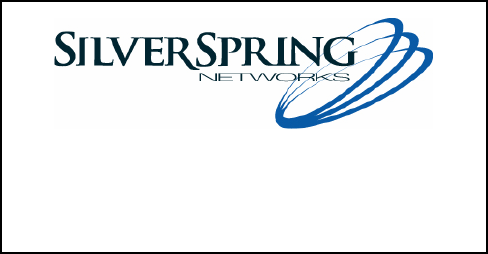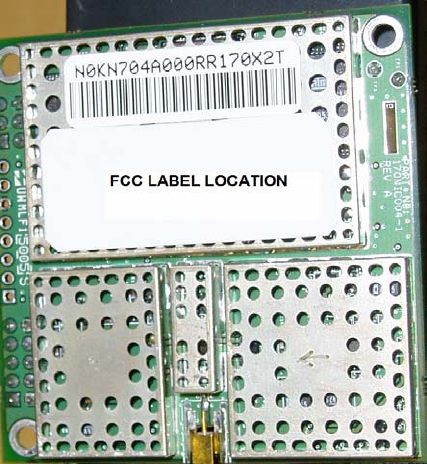Itron NIC41 Utility Meter WLAN Module User Manual 656075
Silver Spring Networks Utility Meter WLAN Module 656075
Itron >
Users Manual

Silver Spring Networks Proprietary Information
Copyright © 2006 Silver Spring Networks, Inc.
1
Silver Spring Networks NICv4.1
Preliminary Product Details Guide
1 Introduction
This guide explains how to install and configure the NIC is a radio device that enables
communication between Silver Spring Networks automated metering infrastructure. It transmits
in the 920 to 928 MHz band and typically transfers data from utility meters to Silver Spring
Networks Relays and Gateways.
1.1 Regulatory
Silver Spring Networks
NIC
FCC ID OWS-NIC41
IC: 5975A- NIC41
The device complies with Part 15 of the FCC rules. Operation is subject to the following two
conditions:
1. The device may not cause harmful interference, and
2. The device must accept any interference received, including interference that may cause
undesired operation.
For Canada:
To reduce potential radio interference to other users, the antenna type and its gain should be
so chosen that the equivalent isotropically radiated power (e.i.r.p.) is not more than that
permitted for successful communication.
Disseminating end-user documentation for the installation/removal of the NICv4.1 is
expressly prohibited by regulatory statues.
Figure 1 is a sample of the FCC ID label that can be found in the location indicated in Figure 2.
The size of the label is approximately 1.75 x 3.50 inches.
Figure 1. FCC ID Sample Label
FCC ID: OWS-NIC41 IC: 5975A- NIC41
This device complies with Part 15 of the FCC Rules. Operation
is subject to the following two conditions: (1) this device may
not cause harmful interference, and (2) this device must
accept any interference received, including interference that
may cause undesired operation.

2
Figure 2. FCC IC Label Location on NIC
This equipment has been tested and found to comply with Part 15 of the FCC Rules. These
limits are designed to provide reasonable protection against harmful interference in a
residential installation. This equipment generates, uses and can radiate radio frequency
energy and, if not installed and used in accordance with the instructions, may cause harmful
interference to radio communications. However, there is no guarantee that interference will
not occur in a particular installation. If this equipment does cause harmful interference to
radio or television reception, which can be determined by turning the equipment off and on,
the user is encouraged to try to correct the interference by one or more of the following
measures:
• Reorient or relocate the receiving antenna.
• Increase the separation between the equipment and receiver.
• Connect the equipment into an outlet on a circuit different from that to which the receiver
disconnected.
• Consult the dealer or an experienced Radio/TV technician for help.
CAUTION: Changes or modifications not expressly approved by Silver Spring Networks
could void the user’s authority to operate the equipment.
FCC RF Radiation Exposure Statement
This device complies with FCC radiation exposure limits set forth for an uncontrolled
environment, and users must follow specific operating instructions for satisfying RF exposure
Compliance. This transmitter must not be co-located or operating in conjunction with any
other transmitter or antenna.
In order to meet FCC’s RF Exposure limits in Section 1.1307 of the Rules, a minimum separation
of 20 cm must be maintained between the antenna of this device during normal operation. The
antenna(s) used for this transmitter must not be co-located or operating in conjunction with
any other antenna or transmitter.

3
IC RF Radiation Exposure Statement
The installer of this radio equipment must ensure that the antenna is located or pointed such
that it does not emit RF field in excess of Health Canada limits for the general population;
consult Safety Code 6, obtainable from Health Canada’s website: www.hc-sc.gc.ca/rpb
This device has been designed to operate with the antennas listed below, and having a
maximum gain of 4.5 dBi. Antennas not included in this list or having a gain greater than 5 dBi
are strictly prohibited for use with this device. The required antenna impedance is 50 ohms.
Acceptable antennas for use with this product include:
Collinear dBi – Maxrad MN9155
Mobile Mark PSKN3-925T
Mobile Mark PSTG0-925HKS
Mobile Mark CVT-925S
KV2 –1 dBi electric meter antenna (manufactured by SSN)
1.2 Safety Information
WARNING!: Severe shock and explosion hazard! Touching energized parts can result in massive
equipment damage, and severe injury or death. Short-circuiting energized parts will result in
blinding flash and explosion. Opening and closing electrical circuits can also produce dangerous
and explosive arc flashes. Involuntary muscular reactions associated with electrical shock may
result in other injuries. Observe the following safety guidelines.
Careful planning of every job is essential. Nothing should be taken for granted. Do not take
chances!
• Read and follow all approved policies and procedures provided by your employer associated
with the procedures in this manual.
• The procedures in this manual must only be performed by qualified workers in accordance
with local utility safety practices, utility requirements, and applicable OSHA and NFPA
standards.
• The information contained in this document is intended to aid qualified personnel, and is
not a replacement for the proper training required to make a person qualified.
• Silver Spring Networks assumes no liability for the customer’s failure to follow these safety
guidelines.
1.3 General Electrical Safety
• Perform the procedures in this manual in accordance with applicable workplace standards
established by the following agencies:
• Occupational Safety and Health Act (OSHA).
• The National Electrical Code published by the National Fire Protection Association
(NFPA-70).
• National Electrical Manufacturers Association (NEMA).
• Electronics Industries Association (EIA).
• Insulated Power Cable Engineers Association (IPCEA).
• American National Standards Institute (ANSI). Whenever possible, de-energize all circuits or
equipment before working on them.
• Maintain a minimum clearance of 10 ft. between line potential and all unqualified persons
at all times.
4
• Keep unauthorized people out of the work area. Be especially cautious of children, who
tend to be drawn to work activity.
• Determining if a circuit is OFF can be difficult in some instances. Check for circuit voltage
with an appropriate voltmeter before working on equipment presumed to have been de-
energized. Tiebreakers, double throw disconnect switches, automatic transfer switches and
emergency generators can supply power through an alternate circuit or from another
source.
• 120V current can be just a lethal as higher voltages because current flow through a body
depends upon the body’s resistance.
• Do not trust insulation and/or weatherproofing on a wire as protection from shock.
• Use electrically insulated tools. Inspect portable electrical equipment or tools for defects
and remove any defective devices from service immediately. All portable electrical
equipment must have Ground Fault Circuit Interrupter (GFCI) protection.
• Select the right tool for the job. Use tools properly. Keep tools in good working order.
• Make sure the work area is free of any flammable material. Flammable vapors can be
ignited by an arc flash.
• Keep the work area clean and dry. Cluttered work areas cause accidents and injuries.
• Provide good lighting in the work area. You cannot work safely if you cannot see what you
are doing.
• Report unsafe conditions or defective equipment to your immediate supervisor.
• Handle material carefully. Lift and carry properly.
1.4 Personal Protective Equipment (PPE)
• Always wear Personal Protective Equipment (PPE), in accordance with OSHA and ANSI
standards.
• Wear eye protection and electrically insulated gloves. Test gloves in accordance with ANSI
standards before use. Do not use gloves that do not pass appropriate test procedures.
• Wear protective clothing such as long sleeve shirts and long pants made of flame resistant
materials.
• Remove all jewelry.
• Do not pass any objects to or from other persons not protected by insulating platforms or
tested, electrically insulated gloves.
1.5 Fall Protection
When performing work at any elevation:
• Always use a fall protection system, in accordance with OSHA standards, whenever
performing work at any elevation.
• Never use conductors, guy wires, pins, or cross-arm braces, etc. to support your weight.
• Whenever using aerial lift devices such as hoists, man-lifts, vehicle-mounted work
platforms and overhead lifts, read and follow the manufacturer’s guidelines for safe and
proper operation.
• Use ladders and scaffolding only in accordance with the manufacturer’s guidelines and/or
according to OSHA standards.
• Only use ladders made of non-metallic, non-conductive material. They should be the
proper size and type for the work intended. Inspect ladders for wear and breakage.
Remove any oil, grease, or other slippery materials.
• Do not set the ladder at too steep or too shallow of an angle. A rule of thumb is to stand
erect with your toes against the bottom rails of the ladder, with your arms extended
straight out. If you can set your palms on top of the rung that is at eye level, the ladder
5
should be at the proper angle. If a ladder angle label is provided, follow its
recommendations.
• If the ladder is to remain in place for an extended period, secure it at the top. The support
point at the top of the ladder should be at least 24 inches (60 centimeters) wide to
maintain support in the event of sideways movement. For jobs of short duration, have a
fellow worker support the ladder at the base.
• Evaluate all tasks to be performed from a ladder for potential fall hazards, such as complex
tasks or situations that require leaning from the side of the ladder.
• The use of scaffolding or a work platform should be considered as an alternative solution in
such cases.
1.6 Shock Accident First Aid
• Do not touch the victim with your bare hands; use something non-conductive to separate
the victim from the energy source.
• Call for emergency medical help immediately. Keep the victim lying down, warm, and
comfortable until help arrives. Avoid moving the victim in case of injury to neck or back.
Position an unconscious victim on a side to let fluids drain.
• Check the victim’s breathing and heartbeat. If properly trained, apply mouth-to-mouth
resuscitation and/or CPR if necessary.
• Remove constricting items from the victim, such as shoes, belts, jewelry, and tight collars;
they could cut off circulation if the victim experiences swelling.
• Apply water or saline for a few minutes to any burns until the skin returns to normal
temperature. Do not attempt to remove clothing that is stuck to a burn. If possible,
elevate burned areas to reduce swelling.
• Make sure the victim receives professional medical attention, even if they feel fine.
Electric shock can cause heart failure hours after the shock is received.